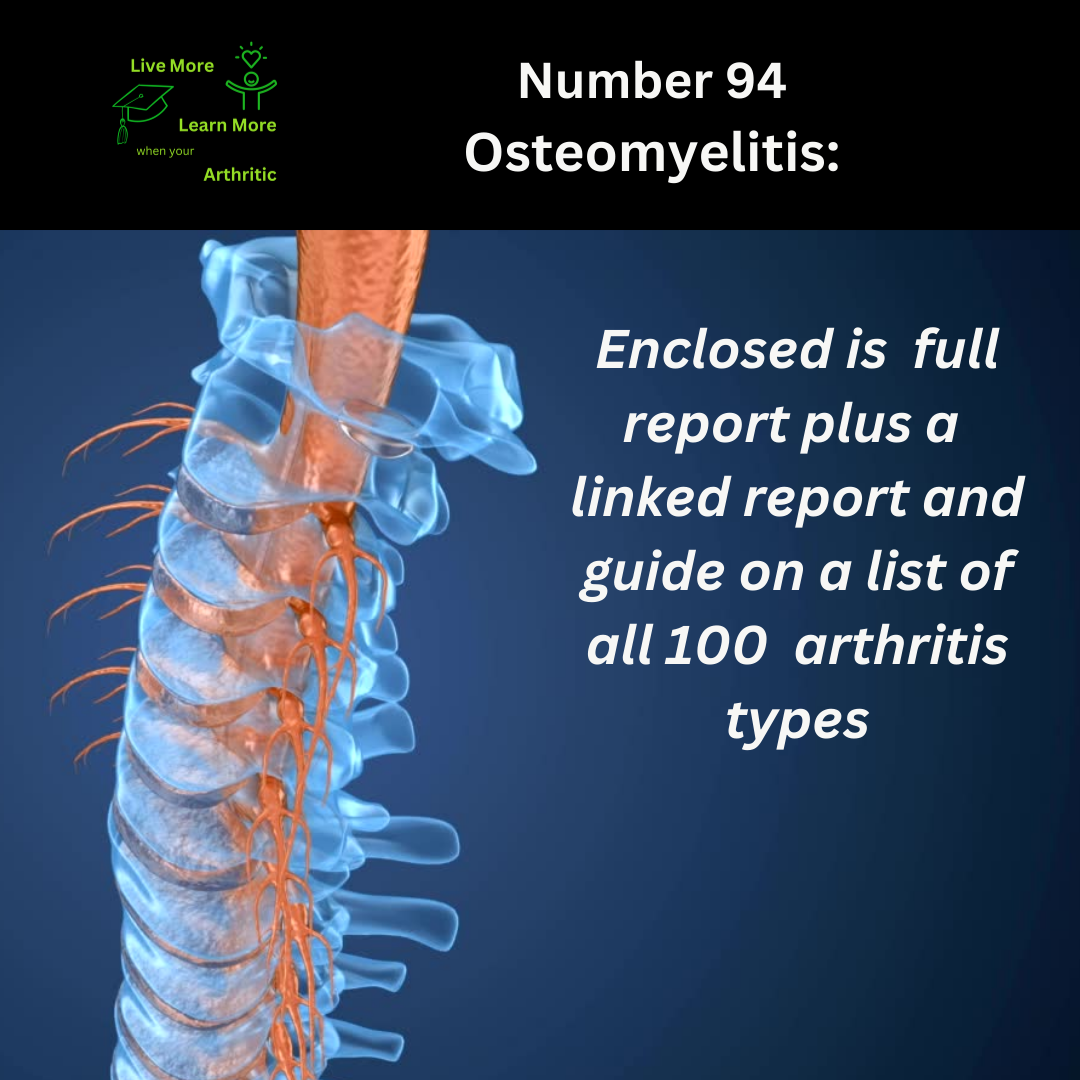
Osteomyelitis: 94 on the list of 100 types of Arthritis
Delving Deeper into Osteomyelitis: Understanding the Intricacies
Most Affected Body Parts and Joints
Osteomyelitis primarily targets the bones, particularly the long bones like the femur (thigh bone) and tibia (shin bone), as well as the vertebrae of the spine and the pelvic bones. In some cases, joints adjacent to infected bones can also become involved, leading to secondary arthritis and joint inflammation.
Osteomyelitis is a serious infection of the bone characterized by inflammation, bone destruction, and the formation of abscesses within the bone marrow. It can be acute (sudden onset) or chronic (long-standing), often caused by bacterial pathogens such as Staphylococcus aureus, which is commonly found on the skin and can enter the bloodstream during trauma or surgery, reaching the bones and causing infection.
Causes and Triggers
The primary cause of osteomyelitis is bacterial infection, typically introduced into the bone through one of several routes:
- Open fractures where bacteria directly enter the bone
- Hematogenous spread via the bloodstream from distant infection sites
- Contiguous spread from nearby soft tissue infections, such as cellulitis or infected wounds
Various risk factors contribute to the development of osteomyelitis, including diabetes, peripheral vascular disease, intravenous drug use, immunosuppression, recent surgery involving bones or joints, and chronic skin ulcers that provide entry points for bacteria.
Symptoms and Limited Range of Motion
The symptoms of osteomyelitis can vary depending on the duration and severity of the infection but often include:
- Persistent bone pain, especially with movement or pressure
- Swelling, redness, and warmth over the affected bone
- Fever, chills, and generalized malaise
- Limited range of motion in nearby joints due to pain and inflammation
Chronic osteomyelitis may present with recurring episodes of symptoms interspersed with periods of relative quiescence.
Age of Onset and Demographics
While osteomyelitis can affect individuals of any age, certain age groups are more vulnerable. In children, acute hematogenous osteomyelitis commonly occurs in those under 5 years old, often affecting the long bones. In adults, chronic osteomyelitis is more prevalent, particularly in those with predisposing conditions like diabetes or peripheral vascular disease.
Complications and Impact on Quality of Life
Untreated or inadequately managed osteomyelitis can lead to several complications, including:
- Chronic, persistent infection requiring long-term antibiotic therapy
- Bone necrosis (death of bone tissue) leading to weakened bones and increased fracture risk
- Formation of bone sequestra (dead bone fragments) that require surgical removal
- Joint destruction and secondary arthritis impairing mobility and function
- Systemic complications such as sepsis, which can be life-threatening
The impact on quality of life can be substantial, with chronic pain, disability, and psychological distress affecting daily activities and overall well-being.
Risk Factors
Numerous risk factors predispose individuals to osteomyelitis, including:
- Diabetes mellitus, which impairs immune function and wound healing
- Peripheral vascular disease, reducing blood flow to affected bones
- Intravenous drug use, increasing the risk of bloodstream infections
- Immunosuppressive conditions or medications that weaken the body’s defenses
- Recent trauma or surgery involving bones or joints, providing entry points for bacteria
Achieving a Higher Quality of Life
A proactive approach to managing osteomyelitis involves:
- Prompt diagnosis through imaging studies (X-rays, MRI, bone scans) and bacterial cultures
- Aggressive antibiotic therapy tailored to the specific pathogen, often requiring long-term treatment
- Surgical intervention for debridement of infected tissue, drainage of abscesses, and removal of necrotic bone
- Rehabilitation with physical therapy to restore mobility, strength, and function of affected limbs
Complications of osteomyelitis can be severe and multifaceted, including chronic pain, recurrent infections, bone deformities, limb shortening, joint stiffness, and long-term disability. In some cases, complications such as septic shock or endocarditis can be life-threatening.
Interconnected Diseases or Conditions
Osteomyelitis is often associated with interconnected conditions such as septic arthritis (joint infection), osteoarthritis (joint degeneration), and systemic infections like endocarditis or sepsis. Close coordination between healthcare providers specializing in infectious diseases, orthopedics, and wound care is essential for comprehensive management and optimal outcomes.



